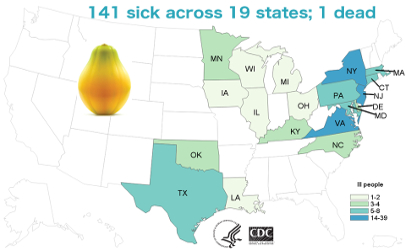Editor’s note: (To read FDA and CDC outbreak updates in Spanish, click on these links:)
Para leer las actualizaciones de brotes de FDA y CDC en español, haga clic en estos enlaces:
FDA https://www.fda.gov/Food/RecallsOutbreaksEmergencies/Outbreaks/ucm568393.htm
CDC https://www.cdc.gov/salmonella/kiambu-07-17/es/index.html
The deadly Salmonella outbreak that has been traced to maradol papayas from Mexico is spreading, with 32 more victims confirmed in the past week and three more states reporting illnesses.
Recalls of three different brands of maradol papayas remain in effect by three fresh produce importers in the United States, as do warnings from federal and state officials urging everyone who has maradol papayas from Mexico to throw them out and clean thoroughly.
 Nineteen states have reported lab-confirmed cases of Salmonella infections, with Illinois, Oklahoma and Texas being added to the list Friday in an outbreak update from the Centers for Disease Control and Prevention.
Nineteen states have reported lab-confirmed cases of Salmonella infections, with Illinois, Oklahoma and Texas being added to the list Friday in an outbreak update from the Centers for Disease Control and Prevention.
More than two-thirds of the 141 victims for whom information is available are Hispanic.
Confirmed illnesses began May 17, with the most recent victim becoming sick on July 27, according to the CDC. One person in New York City died.
Complete information is not available on all 141 victims, but public health officials have confirmed one victim in New York City died. Of 103 victims with hospitalization information available, 45 of them, or 44 percent, had symptoms so severe they had to be admitted.
The other 16 states with confirmed cases of Salmonella Kiambu and Salmonella Thompson are: Connecticut, Delaware, Iowa, Kentucky, Louisiana, Massachusetts, Maryland, Michigan, Minnesota, North Carolina, New Jersey, Ohio, Pennsylvania, Virginia and Wisconsin.
The Food and Drug Administration has confirmed several types of Salmonella bacteria — including the outbreak strains of the Kiambu and Thompson varieties — on a number of different kinds of papaya from the Carica de Campeche farm in Mexico. Three specific brands of maradol variety papayas from that farm have been recalled:
- Caribeña brand, distributed by Grande Produce of San Juan, TX;
- Cavi brand, distributed by Agroson’s Produce of New York City; and
- Valery brand, distributed by Freshtex Produce of Alamo, TX.

Additional brands could be recalled, according to federal officials, who are continuing to traceability efforts to determine what other distributors or importers may have bought papayas from the implicated farm.
“CDC recommends that consumers not eat, restaurants not serve, and retailers not sell maradol papayas from the Carica de Campeche farm in Mexico,” according to the CDC update.
“When in doubt, don’t eat, sell, or serve papayas; just throw them out. Wash and sanitize countertops as well as drawers or shelves in refrigerators where maradol papayas were stored.”
The FDA’s warning is even broader. It warns against eating, serving or selling any kind of papayas from the Carica de Campeche farm, which is in the southern state of Campeche, which borders Guatemala.
“Papayas from the Carica de Campeche farm tested positive for Salmonella Kiambu, Salmonella Thompson, Salmonella Agona, Salmonella Senftenberg, and Salmonella Gaminara,” the FDA reported.
“The Carica de Campeche farm has been added to Import Alert (IA) 99-35. …The FDA increased testing of papayas from Mexico in an effort to see if fruit from other farms could be contaminated. If the FDA finds Salmonella in other shipments, those farms will also be added to IA 99-35.”
The overall size of the ongoing outbreaks of infections from Salmonella Kiambu and Salmonella Thompson bacteria have tripled since the CDC’s initial announcement, which reported 47 victims as of July 21. Public health officials expect that number to continue to increase.
“Illnesses that occurred after July 14 might not be reported yet due to the time it takes between when a person becomes ill and when the illness is reported. This takes an average of two to four weeks,” according to the CDC.
(To sign up for a free subscription to Food Safety News, click here.)
